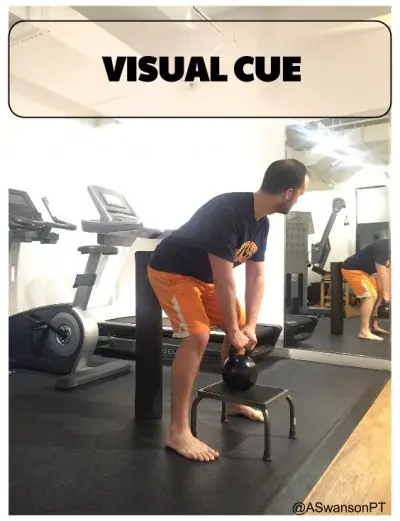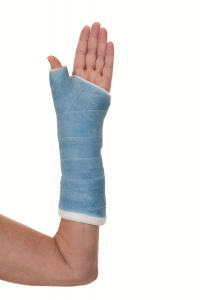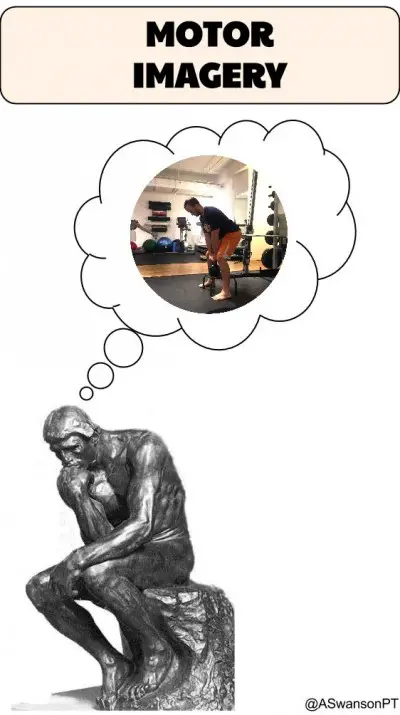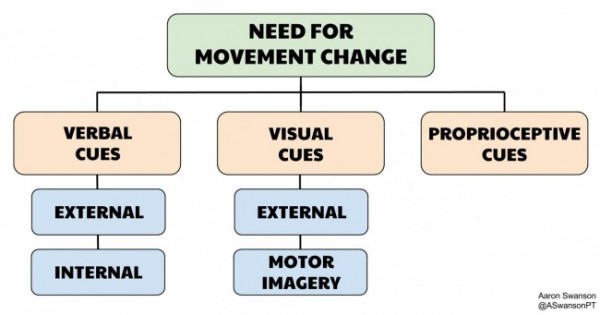Since our species is vision dependent ( >50% of cortex dedicated to processing visual information), visual cues can be an easy way to invoke a sensory change that alters movement patterns. This includes not only the sensory input from our external environment, but also our unique ability to create an internal vision (motor imagery).
Visual Cueing
External Visual Cue
An external visual cue is simply a change in the environment that the person can see. The lines on a road are a simple example of this. The visual input of the lines creates “barriers” that we have to keep our car between. It creates an external reference point in the environment to assist with choosing the correct motor output (driving in a straight line).
Of course, these visual cues must be used in conjunction with an external verbal cue. Driving would be pretty dangerous if people didn’t understand that external verbal cue of “stay between the lines when driving”.
Specifically with movement training, this type of visual cue can quickly change a movement pattern faster and more efficiently than most other types of cuing.
There are two main ways to visually change external environments.
- Create a Barrier
- Create a Target
In the deadlift example I often will place a rolling stool in front of the patients knees, give them the simple external cue of “don’t touch the stool”, and watch them hip hinge cleanly.
But you can just as easily perform the same movement with a target cue. Stand up a foam roller behind them and have them try to hit their butt with it (see picture below). Butt target practice for proper hinging.
Avoiding or reaching for an object usually creates a better movement pattern than an internal cue of “flexing your arm outward” or “push your knee out” (examples: shoulder – knee). It avoids clogging up the processing system and allows the brain to figure out the most efficient way to accomplish the task. It prevents the biggest mistake – the user error.
The examples could go on forever. Since the visual environment is an open system, there is an infinite amount of ways to alter the environment to change movement patterns. Creativity is the only limiting factor here.
Internal Visual Cue – Motor Imagery
Motor imagery can be defined as:
- “an active cognitive process during which the representation of a specific action is internally reproduced in working memory without any overt motor output ”-Decety & Grezes, 1999
In other words, it’s giving yourself an internal cue without performing the movement. The simple act of thinking about internal movement activates some of the same neurons that would fire if you actually physically performed the movement.
It stimulates the “top-down” part of movement. And we know that the cortex is an important variable when it comes to strength. So think of motor imagery as reps for your brain.
This may be the most underutilized coaching and cues in the movement field. Reading some of the research on this makes me wonder why this isn’t a common thing. We are missing out on a ton of potential benefits.
There’s a decent amount of research out on this, however, most of it has been through the lens of neurological rehab or disuse from immobilization. But why not use this to help everyone move better?
- They put two groups in restrictive wrist-hand casts to induce atrophy. One group performed only motor imagery of the involved immobilised muscles. The other group did nothing. The outcomes: the motor imagery group had 50% less strength loss. They essentially strengthened the muscle without using the muscle.
Strengthening the body without using the body? Pretty profound stuff.
Vision
Changing someone’s vision can have profound changed on movement. As a species we are very dependent on our vision and our culture increases this dependency everyday. The easiest way to affect vision is to have the patient close their eyes or to alter fixation, which will have a significant effect on their sensory information. Another way is to cue directional eye movements to change muscle activation and/or challenge stability. The latest vision sensory change trend seems to be with external devices. This can be as expensive as strobe glasses or as cheap as smearing vaseline on swimming goggles.
However, vision can get much more complicated. Working with a dysfunctional visual system can give poor information to the system and influence movement negatively. This is where optometry can have a huge effect on the way people move. This is it’s own deep rabbit hole to jump down. The people at PRI have done a tremendous job at bringing this to light and are a great resource for more information.
Summary
Vision may be the easiest way to change sensory information to augment movement. It can be as easy providing a mirror or as complicated as detailed motor imagery. Which one you choose depends on you and your client’s goals and your patient population.
References in Previous Articles
Coaching & Cueing
Part I – Intro
Part II – The Categories
Part III – Verbal Cues – External
Part IV – Verbal Cues – Internal
Part V – Visual
Part VI – Proprioceptive
Part VI – Summary
—
The main reason I do this blog is to share knowledge and to help people become better clinicians/coaches. I want our profession to grow and for our patients to have better outcomes. Regardless of your specific title (PT, Chiro, Trainer, Coach, etc.), we all have the same goal of trying to empower people to fix their problems through movement. I hope the content of this website helps you in doing so.
If you enjoyed it and found it helpful, please share it with your peers. And if you are feeling generous, please make a donation to help me run this website. Any amount you can afford is greatly appreciated.







